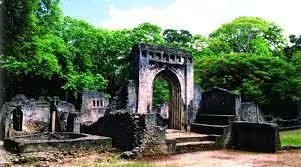Gede Ruins has finally been listed as Kenya’s 8th world heritage site by the United Nations. The historic town and archaeological site was adopted by the United Nations Educational, Scientific and Cultural Organisation (UNESCO) a few days ago. This happened at the 46th session of the World Heritage Committee held in New Delhi, India.
The Culture, Arts and Heritage Principal Secretary, Ummi Bashir, said the recognition highlights Gede’s cultural significance and rich history.
“This new inscription means Kenya now has 8 UNESCO World heritage sites, up from 7 since 2018,” said Bashir.
National Museums of Kenya (NMK) said this will renew focus on conservation efforts and opens new opportunities for sustainable tourism, research, and international cooperation.
UNESCO Selection Criteria
According to NMK, the elevation of Gede followed rigorous evaluation and endorsment by the World Heritage Committee, which acknowledged the site’s outstanding universal value.
Some of the selection criteria for a UNESCO world heritage site inscription are:
- represent a masterpiece of human creative genius
- exhibit an important interchange of human values, over a span of time or within a cultural area of the world, on developments in architecture or technology, monumental arts, town-planning or landscape design
- bear a unique or at least exceptional testimony to a cultural tradition or to a civilization which is living or which has disappeared
- be an outstanding example of a type of building, architectural or technological ensemble or landscape which illustrates (a) significant stage(s) in human history
- an outstanding example of a traditional human settlement, land-use, or sea-use which is representative of a culture (or cultures), or human interaction with the environment especially when it has become vulnerable under the impact of irreversible change;appearances
- directly or tangibly associated with events or living traditions, with ideas, or with beliefs, with artistic and literary works of outstanding universal significance. (The Committee considers that this criterion should preferably be used in conjunction with other criteria)
- contain superlative natural phenomena or areas of exceptional natural beauty and aesthetic importance
History of Gede Ruins
Gede is a small ancient town located in Kilifi County along the Kilifi-Malindi highway. It lies 16 kms south of Malindi town and approximately 90 km North East of Mombasa.
Gede ruins are the remains of a Swahili town, typical of most towns along the East African Coast like Mnarani and Jumba Ruins in Kilifi County.
Its origins can be traced in the 12th century but was rebuilt with new town walls in the 15th and 16th centuries.
This rebuilding is connected with the emigration of many citizens of Kilwa to Mombasa, Malindi and other places along the coast. Owing to the numerous inhabitants, the town became wealthy and it reached its peak in the 15th century. This enormous wealth can be attributed to the presence of numerous ruins, including a conglomeration of mosques; a magnificent palace and houses all nestled in 45 acres of primeval forest.
But in the first half of the 17th century the last families left Gede which led to its eventual abandonment to nature.
Its abandonment is believed to be due to a number of factors like:
i. the Wazimba raid along the East African Coast in 1589 and the Portuguese to Mombasa in 1593.
ii. The falling water table evidenced by the deepening of the well outside the Great Mosque
iii. the overhanging menace of the Galla, a hostile nomadic ethnic group from Somalia.
Gede remains the first intensively studied site on the coast. It was first visited by Sir John Kirk, a British resident of Zanzibar in 1884. Over forty years later in 1927, it was gazetted as a Historical Monument.
Thus, the first archaeological work at Gede began under the direction of James Kirkman followed by the first publication of the site. Gede indigenous forest is a sacred site for traditional rituals and sacrifices for the surrounding community.
Kenya had previously boasted of 7 UNESCO World Heritage sites:
1. Four cultural sites: Lamu Old town, Fort Jesus, Sacred Mijikenda Kaya Forests and Thimlich Ohinga Archeological site
2. Three natural sites: Mount Kenya National Park, Lake Turkana National Park and Kenya Lake system in the Great Rift Valley (Lake Bogoria, Lake Nakuru and Lake Elementaita).



